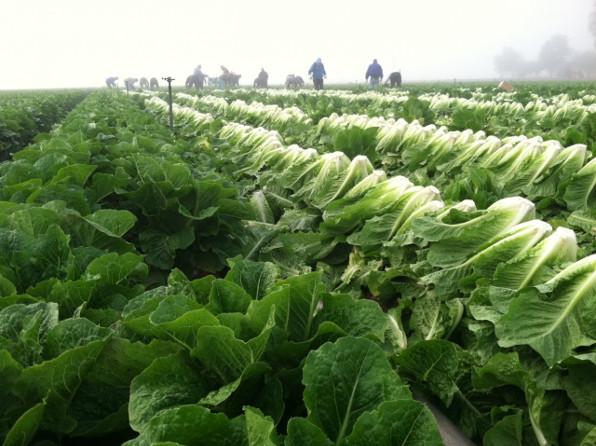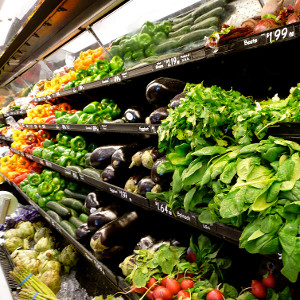Lettuce prices will rise further through this spring. That’s the industry forecast. And it’s especially true of retail prices here in Canada where we rely on lettuce from California, Texas, Arizona, and Mexico through our cold months…
 Fresh produce: Should be part of ever meal, regardless of prevailing supermarket prices.
Fresh produce: Should be part of ever meal, regardless of prevailing supermarket prices.
Above: Km upon km of Romaine lettuce in Central Caliofornia, in better years…
Lettuce prices have long been taken as an indicator of the state of produce prices in general. As the California crop goes, so go both prices and supplies of fresh produce across North America.
The latest predictions call for prices to rise through this spring and remain high through the rest of the summer. But don’t blame the war in Ukraine, greedy supermarkets or global economic disruptions. It’s mainly the weather – driven by global warming – that’s behind the increases.
First drought, now flooding
We just can’t win. Fresh food prices shot up at least partly due to abiding drought in Central and Southern California over the past few years. Now, a sudden change in the weather has been delivering record rains and high-altitude snowfalls which are translating to massive flooding in the state’s most important agricultural regions.
The Salinas Valley, where a vast amount of lettuce and other produce eaten in North America is grown every year, has seen severe rain and storms since the beginning of the year, John Bishop, national buyer for produce distributor Fresh Start Foods told CTV News recently. “All that extra water has flooded fields and delayed planting,” Bishop said, causing hundreds of thousands of dollars in crop damage. “It’s been very concerning.”
Farmers frustrated, but not ruined
Farmers, some of whom grow kilometres upon kilometres of rows of leafy greens every season, are missing out on millions upon millions of dollars in profits. But they’re also being saved from outright bankruptcy by crop insurance. Some have elected simply not to try to plant anything in the first place the past few punishing years.
Anyway, don’t worry about them. They will be there to pick up where they left off when the weather stabilizes. The question is, when is that likely to be?
Off-the-shelf reality
I’ll bet we can all recall when a nice crunchy head of good old Iceberg Lettuce cost around $0.99. This week, it’s $3.49 per head. Romaine, my go-to lettuce for all applications, has been particularly hard-hit. Just two or three years back it could be had in 3-head bags for around $4.00. Late last fall, that same 3-head bag hit $7.99. It’s been hovering around there since then, drifting a little higher week to week, but never goes down significantly.
The story is the same for everything in the produce department – unless it’s being used as a loss-leader by the retailer. For those who don’t know, a loss-leader is a popular product priced artificially low to get you into the store. Once there, the store wants you to buy all your produce there at regular prices. It’s counting on your addiction to convenience.
The word ‘loss’ comes into play because the store may actually lose money on the product to make the whole deal attractive enough to attract you. Problem is, you never know when, or on what products, loss-leader deals will be offered.
How you can ‘take control’?
The obvious way to take control of your fresh produce costs is to grow at least some of it yourself. Easy to say if you have a big back yard with decent soil. It’s easy to plant leafy greens. These days, seeds come embedded in paper ‘tapes’ that spaces them properly. All you do is prepare a trench to the right depth, cover lightly and water. Nature does the rest.
Other common veggies, such as onions and carrots, also come on seed tapes. Potatoes, sweet corn, green and yellow beans, melons, and squash can all be grown just by digging a hole in your tilled, prepared garden bed and dropping in the seeds.
Take it to the next stage
Of course, some veggies – such as Tomatoes and other soft fruits and veggies that have tiny, delicate seeds – are best started early, in February, indoors where you can control the environment.
You can get as involved in veggie micro-farming as you want. But do take into account what your time is worth and how much seeds and supplies are costing you. Need help or advice? Don’t forget that your own grand parents or great grand parents probably planted their own lush gardens every year!
And remember…
You can always buy pre-started seedlings for any of the popular veggies once the garden centres open for the season in mid-late may. And you can plant just a few plants in balcony planters or window boxes if you want to supply yourself with just enough produce to provide fresh leafy greens every day.
One reason I’m posting this annual reminder now is that it’s time to plant your seeds ahead indoors to get a jump on the season!
Bottom line:
There are alternatives to paying outrageously high prices, or cutting fresh foods out of your diet entirely. I just want to encourage you to explore some of the ways I’ve suggested to keep fresh foods in your diet while waiting to see what the weather is going to do. I can’t emphasize too much ow important it is just to have some leafy greens on your plate every day. And you’ll be healthier and enjoy dining more if you have at least one item of fresh produce of some kind on your menu every meal!
~ Maggie J.

